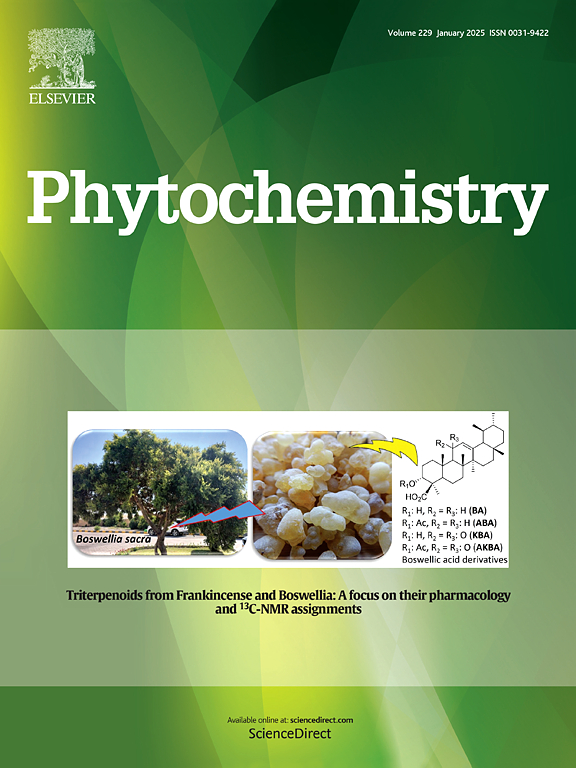Labdane-type diterpenoids from Hypoestes phyllostachya inhibit pancreatic cancer stem cells
IF 3.4
2区 生物学
Q2 BIOCHEMISTRY & MOLECULAR BIOLOGY
引用次数: 0
Abstract
Ten previously undescribed labdane diterpenoids, hypochins A-J (1–10), were isolated from the aerial parts of Hypoestes phyllostachya with white spots. Their structures and absolute configurations were elucidated through comprehensive spectroscopic characterization, including IR, HRMS, NMR, electronic circular dichroism analysis, single-crystal X-ray diffraction, and biosynthetic considerations. Notably, compound 10 represents a rare labdane diterpenoid incorporating 16,15;19,6-dilactone units. Compound 1 exhibited potent inhibition of sphere formation in pancreatic cancer stem cells (PCSCs), which are known to drive tumor growth and contribute to resistance against cancer therapies. The suppression of PCSCs by 1 was confirmed by the down-regulation of cancer stem cell markers CD44, CD133, Oct-4, Sox-2, ALDH1A1, Musashi1, CXCR4, and PON1. Further investigations demonstrated that 1 suppressed the self-renewal of PANC-1 cells and inhibited their migration and invasion by suppressing epithelial-mesenchymal transition. Moreover, the selectivity of 1 against PCSCs and pancreatic cancer cells was evaluated through apoptosis analysis. Compared to paclitaxel, which is effective against cancer cells but inactive on PCSCs, compound 1 induced marked apoptosis in PCSCs, demonstrating its selectivity as a PCSC-targeted inhibitor. These results address the critical need for therapies that specifically target PCSCs, which play a crucial role in pancreatic cancer progression.

从竹竹中提取的labdane型二萜抑制胰腺癌干细胞
从具有白色斑点的地生叶中分离得到10个先前未被描述过的唇形二萜,Hypoestes A-J(1-10)。通过全面的光谱表征,包括IR、HRMS、NMR、电子圆二色分析、单晶x射线衍射和生物合成考虑,阐明了它们的结构和绝对构型。值得注意的是,化合物10代表一种罕见的含16,15的labdane二萜;19日,6-dilactone单位。化合物1在胰腺癌干细胞(PCSCs)中显示出对球体形成的有效抑制,PCSCs是已知的驱动肿瘤生长并有助于抵抗癌症治疗的细胞。通过下调肿瘤干细胞标志物CD44、CD133、Oct-4、Sox-2、ALDH1A1、Musashi1、CXCR4和PON1,证实了1对PCSCs的抑制作用。进一步研究表明,1通过抑制上皮-间质转化,抑制PANC-1细胞的自我更新,抑制其迁移和侵袭。此外,通过细胞凋亡分析评估了1对PCSCs和胰腺癌细胞的选择性。与紫杉醇相比,化合物1对癌细胞有效,但对PCSCs无活性,化合物1在PCSCs中诱导了显著的凋亡,表明其作为pcsc靶向抑制剂的选择性。这些结果解决了针对PCSCs的治疗的关键需求,PCSCs在胰腺癌进展中起着至关重要的作用。
本文章由计算机程序翻译,如有差异,请以英文原文为准。
求助全文
约1分钟内获得全文
求助全文
来源期刊

Phytochemistry
生物-植物科学
CiteScore
6.40
自引率
7.90%
发文量
443
审稿时长
39 days
期刊介绍:
Phytochemistry is a leading international journal publishing studies of plant chemistry, biochemistry, molecular biology and genetics, structure and bioactivities of phytochemicals, including ''-omics'' and bioinformatics/computational biology approaches. Phytochemistry is a primary source for papers dealing with phytochemicals, especially reports concerning their biosynthesis, regulation, and biological properties both in planta and as bioactive principles. Articles are published online as soon as possible as Articles-in-Press and in 12 volumes per year. Occasional topic-focussed special issues are published composed of papers from invited authors.
 求助内容:
求助内容: 应助结果提醒方式:
应助结果提醒方式:


